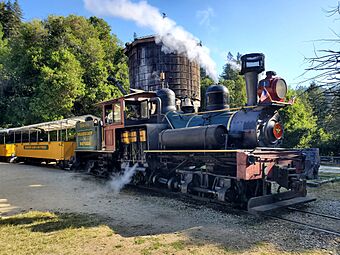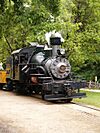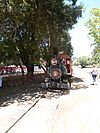- This page was last modified on 27 October 2025, at 02:50. Suggest an edit.
Roaring Camp & Big Trees Narrow Gauge Railroad facts for kids
 |
|

The Dixiana at Roaring Camp in 2023
|
|
| Overview | |
|---|---|
| Headquarters | Felton, California |
| Reporting mark | RCBT |
| Locale | Santa Cruz County, California, US |
| Dates of operation | 1963–present |
| Technical | |
| Track gauge | 3 ft (914 mm) |
The Roaring Camp & Big Trees Narrow Gauge Railroad is a special train line in California. It's a narrow-gauge railway, which means its tracks are closer together than standard tracks. This fun tourist train starts at the Roaring Camp station in Felton, California. It travels up steep hills through beautiful redwood forests. The journey goes all the way to the top of Bear Mountain, covering about 3.25 miles.
Most of the trains here are pulled by amazing steam locomotives. Some of these engines are very old, dating back to the 1890s! They are among the oldest narrow-gauge steam locomotives in the United States that still carry passengers regularly. For example, Knott's Berry Farm has two engines from 1881, and the Cumbres & Toltec Scenic Railroad has one from 1883.
In 1988, the American Society of Mechanical Engineers recognized three of this railroad's locomotives as important "Historic Mechanical Engineering Landmarks." This shows how special and historically significant these machines are.
Contents
How the Roaring Camp Railroad Started
The story of Roaring Camp began in 1867. A businessman from San Francisco, Joseph Warren Welch, bought the Big Trees Ranch. He wanted to protect the giant redwood trees from being cut down. This was the first time someone bought land in California just to save its trees! Later, in 1930, part of this land was sold to Santa Cruz County. It eventually became part of the beautiful Henry Cowell Redwoods State Park.
The Roaring Camp Railroads officially started running in 1963. It was founded by F. Norman Clark (1935–1985). He wanted to continue his family's tradition of building railroads. His goal was to bring back the exciting and romantic feeling of steam trains to America.
In 1958, Mr. Clark discovered an old engine named Dixiana. It was abandoned near a coal mine in the Appalachian Mountains. He said it looked like a "rusty pile of junk"! But he worked hard to fix it up. The Dixiana started carrying passengers in 1963. It ran on tracks that had traveled all the way around Cape Horn back in 1881. Mr. Clark carefully planned the railway route. He wanted to cut down as few trees as possible on the 170 acres he leased for 99 years.
Overcoming Challenges: Fire and Switchbacks
The original railway had two big wooden bridges, called trestles. They formed a special "corkscrew" loop at Spring Canyon. But in 1976, a large fire destroyed these trestles. The smoke from this fire was so big it could be seen from San Francisco! It was believed that the fire was set on purpose.
The railroad quickly found a solution. Within six months, they built a "switchback" to go around the damaged loop. A switchback is a special track design that allows a train to climb a steep hill by going forward, then backward, then forward again. This new switchback has a very steep slope, about 10.5%. Because of its design, trains using the switchback can only have six cars or fewer. If a train is longer, a diesel engine helps move the extra cars up and down separately.
After F. Norman Clark passed away in 1985, his wife, Georgiana, took over running the railroad. In 2003, Roaring Camp hosted its first "Day Out with Thomas" event. This was a huge success! About 25,000 people visited over three days, making it the biggest event in the railroad's history at that time. On December 28, 2015, a train had a small accident. It bumped into a stop block on the switchback, and six people were injured. This happened because of a mix of driver error and a problem with the engine's throttle valve.
Meet the Locomotives
The Roaring Camp Railroads has many different locomotives. Some are ready to run, while others are being repaired. The main trains you'll see are usually pulled by two Shay locomotives. Sometimes, a Heisler engine also makes an appearance. The oldest engine, "Kahuku," is a small 0-4-2T type. It's used for short trips on special days because it's not big enough to pull trains up the steep mountain.
Here's a look at some of the special locomotives:
| Number | Name | Image | Builder | Type | Built | Notes |
|---|---|---|---|---|---|---|
| #1 | Dixiana |  |
Lima Locomotive Works | Class B Shay | 1912 | This engine is named after a mining railroad in Dixiana, Virginia. It is currently running and used regularly. |
| #2 | Tuolumne |  |
Heisler Locomotive Works | 2-truck Heisler | 1899 | This engine used to work for the West Side Lumber Company. It is currently running and was restored in 2001 and 2010. |
| #3 | Kahuku |  |
Baldwin Locomotive Works | 0-4-2ST | 1890 | This engine came from a plantation in Kahuku, Hawaii. It is running and used for special events. |
| #4 | Waipahu | Baldwin Locomotive Works | 0-6-2T | 1897 | This engine was sold to a theme park in Japan in 1988. | |
| #5 | Bloomsburg | Climax Locomotive Works | Class B Climax | 1928 | This engine is currently not running, but there are plans to rebuild it. | |
| #6 | Daisy |  |
Lima Locomotive Works | Class B Shay | 1912 | This engine is currently not running. |
| #7 | Sonora |  |
Lima Locomotive Works | Class C Shay | 1911 | This engine is currently being repaired and overhauled. |
| #40 | Plymouth Locomotive Works | 14-ton Diesel | This diesel engine is currently running. | |||
| #50 |  |
Davenport Locomotive Works | Diesel | This diesel engine is running and is now at the Colorado Railroad Museum. | ||
| #50 (2nd) | General Electric | 25-ton Diesel Electric | This diesel engine is running and was sold to the Kauai Plantation Railway in 2010. | |||
| #60 | General Electric | 56-ton Diesel Electric | This diesel engine is not running and was sold to the Georgetown Loop Railroad in 2010. | |||
| #?? (30?) | Whitcomb Locomotive Works | This engine was obtained in 2010 and sold in 2013. | ||||
| #10 | Milwaukee Locomotive Manufacturing Company | Motorcar | This motorcar is currently running. |
Special Historic Engines
In 1988, the American Society of Mechanical Engineers recognized three of Roaring Camp's special engines as "National Mechanical Engineering Historical Landmarks." These were the Shay, Climax, and Heisler engines. They are great examples of the small, slower steam engines used in the 1800s.
- Locomotive #1: Dixiana'
This engine was built in 1912. It first worked for a lumber company in Tennessee. The Dixiana is named after a small mining railroad. It has a unique look because its boiler is set a little to the left. This helps balance the engine's weight.
- Locomotive #2: Tuolumne'
Built in 1899, this engine first worked for a sawmill near Tuolumne City. It was named Thomas S. Bullock after the first manager of the lumber company. Roaring Camp bought it in 1962. It is the last steam engine used for commercial lumber work in Tuolumne, California. It is also the oldest Heisler engine still running today.
- Locomotive #5: Bloomsburg'
The Bloomsburg was built in 1928 for a coal and lumber company in West Virginia. It had several owners before Roaring Camp bought it in 1975. This engine is believed to be the last of its kind, made by Climax, that worked in the logging industry in the western United States.
Images for kids
See also
- List of heritage railroads in the United States
- Logging railroad
- Santa Cruz, Big Trees and Pacific Railway
- Santa Cruz Railroad
- U.S. common-carrier narrow gauges in the twentieth century


